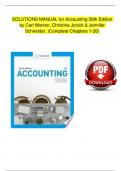Exam (elaborations)
Solution Manual For Accounting 28th Edition by Carl S. Warren, Christine Jonick| Verified Chapter's 1 - 26 | Complete
Solution Manual For Accounting 28th Edition by Carl S. Warren, Christine Jonick| Verified Chapter's 1 - 26 | Complete
[Show more]



